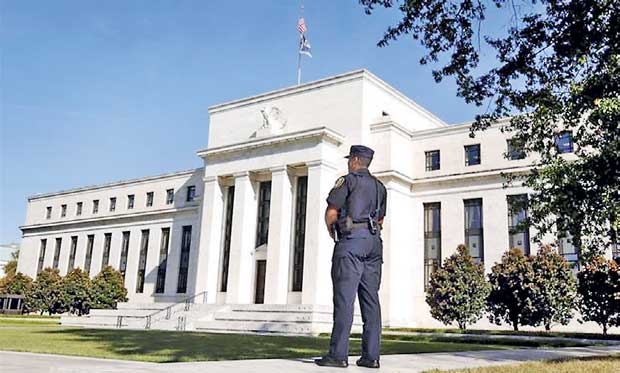20 Jun 2017 - {{hitsCtrl.values.hits}}

 For global financial markets, the US interest rate outlook is the elephant in the room. Sharply higher rates could destabilize markets, particularly in emerging Asia where rising debt levels are shaping as a threat to growth.
For global financial markets, the US interest rate outlook is the elephant in the room. Sharply higher rates could destabilize markets, particularly in emerging Asia where rising debt levels are shaping as a threat to growth.
Action is needed to reduce leverage levels in case rates rise faster than expected. So far, the US Federal Reserve has raised its benchmark federal funds rate only gradually although this may change if economic growth or inflation accelerates.
This gradual normalization of US monetary policy follows a long period of very low rates since the Fed’s emergency policy responses during the global financial crisis. Further rate hikes are expected this year and next, as well as a possible reduction by the Fed of its securities holdings.
How quickly the Fed moves will be crucial. In May 2013, the mere suggestion of its intention to reduce securities purchases triggered a bout of instability in financial markets in Asia and elsewhere-the so-called taper tantrum.
What would be the consequences for Asia of ongoing US rate rises? The first would likely be tighter liquidity conditions in the region.
If the US economy grows strongly, higher rates could drive relative interest differentials in favour of the US. This could spur international capital flows to the US, strengthening the dollar. More interest rate hikes in the US could further drain foreign investment from emerging Asia, subjecting major Asian currencies to depreciation pressures.
It’s unlikely that this could lead to competitive currency depreciations in Asia, as currency weakness will trigger further capital outflows.
But tighter US monetary policy might reverberate in emerging Asian markets, especially those with open capital accounts and flexible exchange rate regimes. Rising US interest rates would reduce liquidity in these economies, thereby slowing growth. Another potential threat to growth is the rapid expansion of debt in Asia’s public and private sectors. One major risk from this is a currency mismatch due to surging foreign currency debt. Outstanding foreign currency debt in emerging Asia doubled from 2010 to 2016, due mainly to global monetary easing and a weak US dollar. Corporate foreign currency debt increased by more than 150 percent. Increasing foreign currency debt also raises the prospect of debt-servicing problems due to currency mismatches, which happen when domestic corporates borrow in foreign currency but generate profits in local currency. This is profitable when the dollar is weak but when it’s strong, corporate balance sheets come under pressure.
Asia must prepare for tightening global liquidity conditions
Outstanding local currency corporate bonds in select emerging Asian economies expanded by 280 percent between 2008 and 2016, while government bonds increased by 139 percent. Tightening liquidity conditions would decrease the market value of these debt assets and weaken the balance sheet of institutions, challenging financial stability.
Moreover, some emerging Asian economies have seen growing non-performing loan ratios since 2012. Widening credit spreads have caused concern, prompting investors to claim higher premiums for increasing default risks.
In the short term, these risks are manageable. The region’s healthy growth and strong fundamentals, relatively sound prudential regulation and improving macro-prudential policies, will help to protect economies.
Nevertheless, Asia needs to prepare itself for tightening global liquidity conditions.
Measures to gradually reduce leverage levels-especially in less-efficient sectors and industries suffering from overcapacity-are needed to spur structural transformation and upgrading and promote greater long-term resilience of financial systems.
In some parts of the region, this is already happening. Korean conglomerates began deleveraging and restructuring last year against a backdrop of prolonged weak global demand. In addition to shedding excess debt, Hyundai Heavy Industries, Doosan Heavy Industries & Construction and POSCO have reduced non-core assets.
The challenge for governments will be to lower leverage levels without triggering short-term turbulence in the financial system.
One way to do this is to withdraw implicit or explicit guarantees of government bailout in case of bankruptcy. This would encourage highly leveraged companies to cut their debt levels just to survive and discourage companies from borrowing excessively in the first place.
Policy measures targeting highly indebted sectors are preferable to those that might harm the wider economy. For example, loan-to-value and debt-to-income limits on borrowers can prevent housing market bubbles, without causing the wider economic pain that tightening liquidity conditions can inflict.
The best way for authorities to protect financial stability is to always keep a close eye on debt. That way, they won’t face tough choices between growth and deleveraging down the track.
(Donghyun Park is the Principal Economist, Economic Research and Regional Cooperation Department, ADB)
08 Jan 2025 6 minute ago
07 Jan 2025 7 hours ago
07 Jan 2025 7 hours ago
07 Jan 2025 8 hours ago
07 Jan 2025 07 Jan 2025